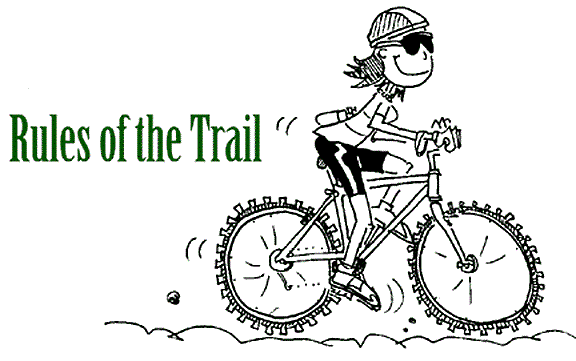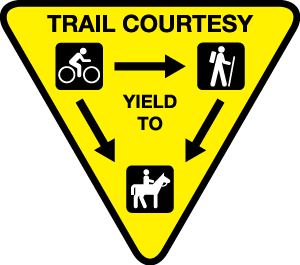
SHARE THE TRAIL
There’s a saying: You’ll never win a fight with an automobile. The same general rule applies to any situation in which you find yourself – the bigger object wins. On trails, a hiker is about the smallest, slowest object so it is in your best interest to yield to any other mode of transportation you encounter.

A commonly used trail sharing sign is shown here.
The rules are:
-
- Bikers yield to hikers and horses.
- Hikers yield to Horses.
- Motorized users yield to all trail users.
The concept is that bikers are fast and can stop and go easily so they let everything else have the right of way. Horses are big and unpredictable so they get the right of way.
As a slow, unprotected hiker, I’m not about to argue the right of way with a horse or biker or ATV or anything else I might meet. I will always politely yield the trail and use the time to take a deep breath and say ‘Howdy’.
Here are a bunch of tips to make it easier to share the trail with others. Please remember these and try to follow them and pass them on to new hikers:
- Stay on the trail. Do not cut switchbacks or take shortcuts.
- Stay to the right on wider paths.
- Pass on the left.
- When overtaking someone, let them know you are approaching and will be passing on their left. You may hear a biker call out, “On your Left!” as he comes up from behind. That means you should stay to your right.
- Whenever you stop for a view, a rest, or to yield, move off the trail so it is free for others. If you are selecting the spot for a rest, get off on a used area or a durable surface such as a rock, dirt, or snow. Don’t just trample off the trail into a nice soft field of grass and flowers.
- Hikers going uphill are working hard and should be given the right of way over hikers coming downhill. Sometimes uphill hikers will prefer to stop and let you pass coming down so they can get a short break. The uphill hiker should get to make the call.
- Greet people you meet. This makes sure they know you are there and is polite. A simple “Howdy” or “Nice Day” is fine.
- When hiking in a group, yield to single or pair hikers. It’s harder for a group to get off the trail so often times singles will stop and let you all pass, but its their call.
- When hiking in a group, hike single file or take no more than half of a wide trail. Make sure everyone in your group understands what actions to take when encountering hikers, bikers, and motorized users.
TRAIL USER.S SAFETY CODE
It is every trail users responsibility and right to ensure their own safety and expect safe practice from other trail users. Exercise caution at all times, follow guidelines and rules of the trails. Preventing accidents or injuries is the first step, acting responsibly if something does happen is the second. Always think and look ahead.
A TRAIL USER’S CODE OF ETHICS
- Avoid trail conflicts with trail user and there means of using the trail.
- Respects the rights of other trail users.
- Respect nature and the environment.
- Leaves only footprints, or wheel tracks to tell of their passing.
- Give a horse a wide berth.
- Uses only the route identified as the trail. Obey signs.
- Always pass on Right, Stay right when approaching oncoming users.
- Don.t Cruise with Booze or any other substance that may impair your judgment.
- Clean up after your dogs or horses. Scoop it up and throw it well off the trail, avoid contaminating water sources like springs, creeks, waterways.
- Try to help anyone in trouble or with less experience.
- Take only memories – leave only footprints!
A TRAIL USER’S GUIDE FOR ENVIRONMENTAL AWARENESS
- Do not litter. What you carried in, you can carry out. And if you have room pick up what others have carelessly left behind.
- Do not smoke while using the trail . or use designated areas. Be careful to butt out, completely. You don’t want to be responsible for a forest fire.
- Leave your campsite neat and tidy. Return your site to as natural looking as possible.
- Stay on the trail and avoid unnecessary destruction of vegetation and may even lead to soil erosion. Leave wildlife and plants for others to enjoy
- Never approach or feed wild animals, they can be unpredictable and can be very dangerous
- Is the fire out? If you are going to have a small fire, Make sure it is properly extinguished. During the hot summer months there may be a fire restriction so check first.
A TRAIL USER’S GUIDE TO PUBLIC AWARENESS
- Be friendly towards other trail users. Stop, speak, and answer questions, whatever it takes to present a good image of all trail users.
- Avoid trail conflicts by slowing down and stopping to let them by.
- Don.t cruse with booze, it makes you look bad on the trail and it.s illegal too.
- Leave Right of Way gates how you find them, Respect the privacy of landowners bordering the trails.
- Please don.t hunt on this recreation trail, if you hunt use other trails or roads.
- It’s the Law in British Columbia to wear a helmet when using the trail. Motorized users must also wear a helmet.
- Any equestrian or motorized vehicle user under the age of 16 should be accompanied by an adult.
A TRAIL USER’S GUIDE TO CAMPSITE ETIQUETTE
- Be self-sufficient for all your needs. Bring your own food, toilet and camping supplies as well as all equipment you might need.
- Bring all foreign water to a full boil; Water may be scarce during the dry summer months, Carry your own water in. Note: There are plenty of creeks and water springs along the trail- check your guide books for more on drinking water on the trail.
- Campfires are permitted in designated areas only. During dry summer mouths, Fire Restrictions may be in place. Check with Forestry officials before lighting one.
- Keep your campsite clean and take your garbage home with you.
- Be Bear Aware.
 Be prepared for your safety
Be prepared for your safety
- Always be alert and respectful of wildlife.
- Expect Snow or Rain at any-time. Dress for significant weather changes. Wear good foot wear.
- Carry plenty of water. Open sources of water may not be safe to drink without filters or treatment.
- Use a headlamp or flashlight in tunnels.
- Be aware of rockfalls, slides and washouts.
- Be aware of communication limitations. Cellular telephone coverage may not be available.
- BC Law requires cyclists to wear helmets at all times.
- Use caution near rivers and creeks. Strong currents exist.